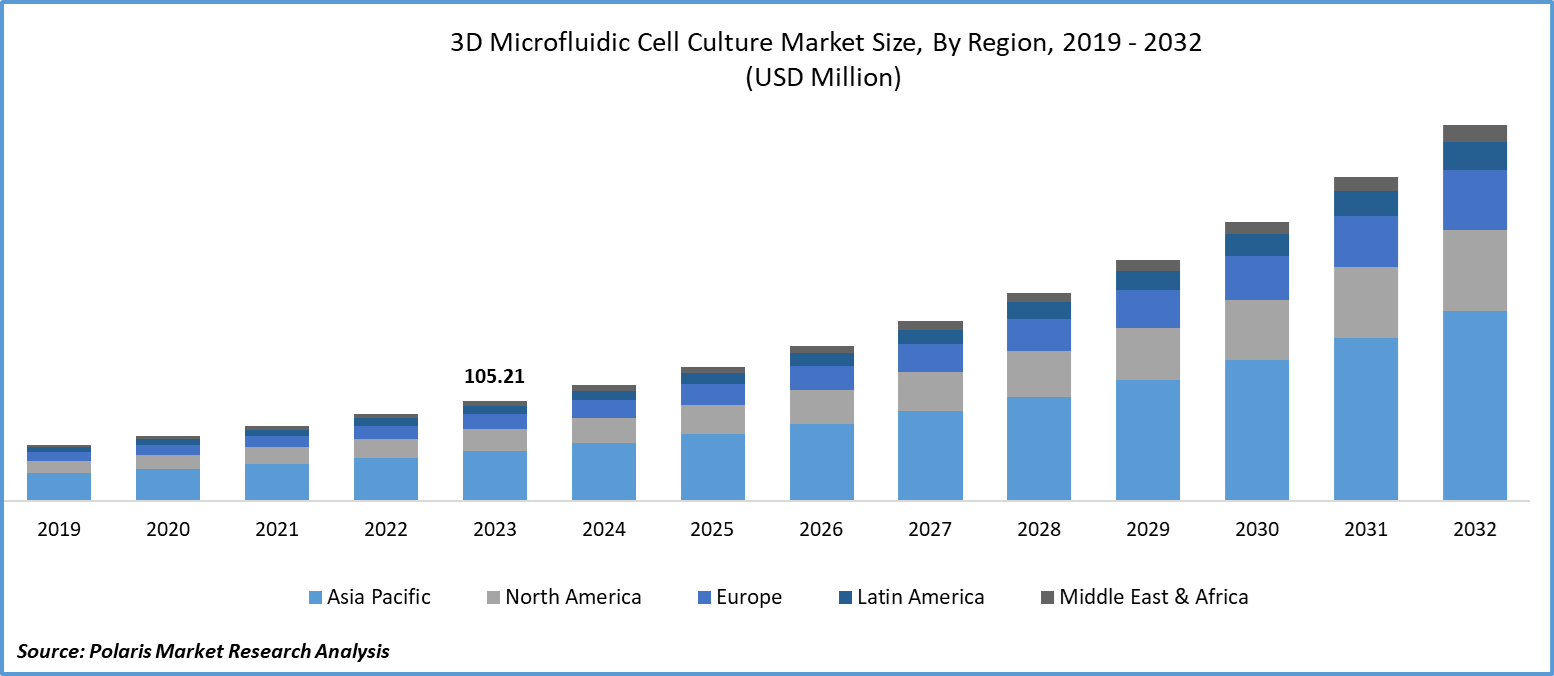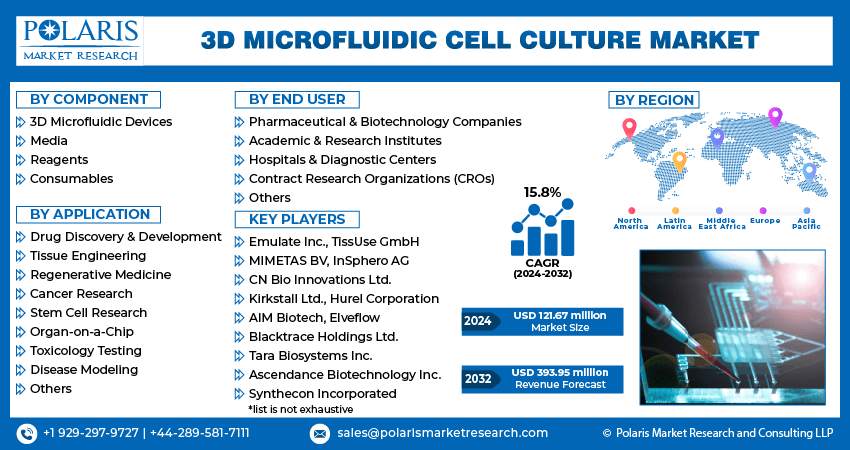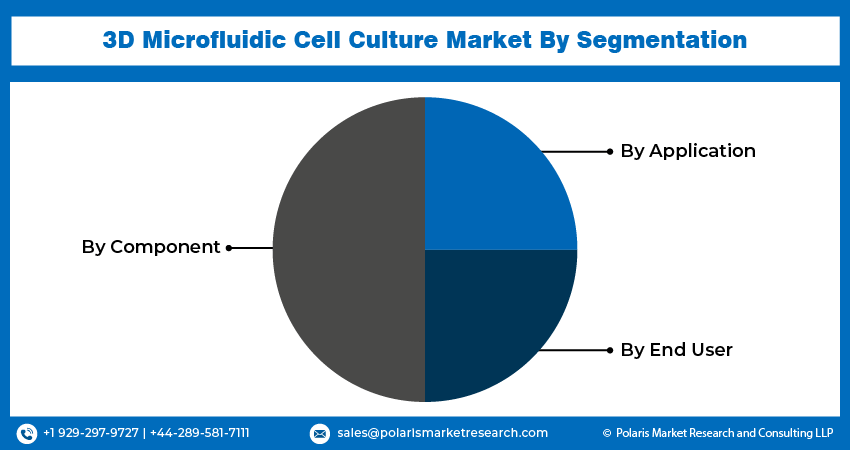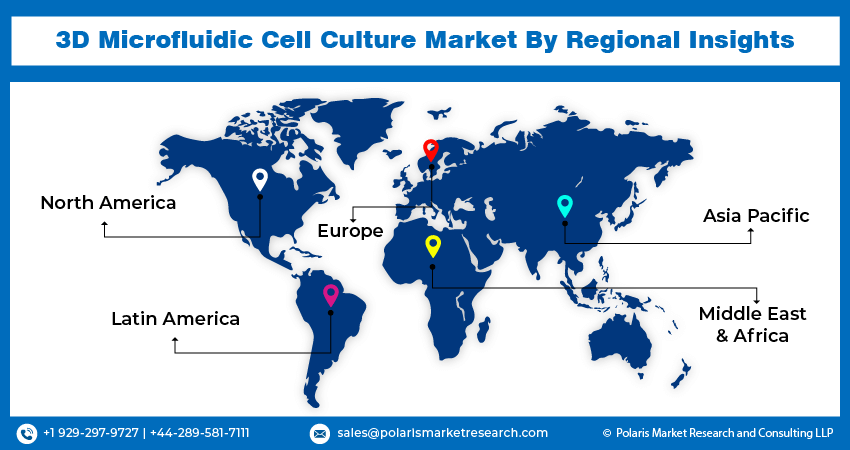
3D Microfluidic Cell Culture Market Size, Share, Trends, Industry Analysis Report
: By Component (3D Microfluidic Devices, Media, Reagents, and Consumables), By Application, By End-User, and By Region (North America, Europe, Asia-Pacific, Latin America and Middle East & Africa) – Market Forecast, 2024 - 2032
- Published Date:Aug-2024
- Pages: 117
- Format: PDF
- Report ID: PM5032
- Base Year: 2023
- Historical Data: 2019-2022
Report Outlook
Global 3D microfluidic cell culture market size was valued at USD 105.21 million in 2023. The market is projected to grow from USD 121.67 million in 2024 to USD 393.95 million by 2032, exhibiting a CAGR of 15.8% during the forecast period.
The 3D microfluidic cell culture market involves technologies that create three-dimensional environments for cell growth within microfluidic devices. These systems enhance cell culture precision, mimic natural tissue conditions, and support advanced research in drug development and disease modeling.
The global 3D microfluidic cell culture market is experiencing significant growth, driven by advancements in tissue engineering, regenerative medicine, and drug discovery. Key drivers include the increasing demand for more accurate and physiologically relevant cell culture models, which better mimic in vivo environments compared to traditional 2D cultures. The rise in chronic diseases and the push for personalized medicine are also propelling market growth. Emerging trends include the integration of AI and machine learning for enhanced data analysis and the development of automated, high-throughput microfluidic platforms, which are expected to revolutionize drug testing and biomedical research.

To Understand More About this Research:Request a Free Sample Report
3D Microfluidic Cell Culture Market Drivers and Trends
Integration of AI and Machine Learning
The integration of artificial intelligence (AI) and machine learning (ML) into 3D microfluidic cell culture systems is transforming the landscape of biomedical research and drug development. These technologies enable the automation and optimization of experimental processes, allowing for real-time analysis and interpretation of complex biological data. AI-driven algorithms can predict cell behavior and optimize conditions within the microfluidic environment, improving the accuracy and efficiency of drug testing and personalized medicine. As these technologies advance, they are expected to play a crucial role in accelerating research timelines and reducing costs associated with drug development.
Development of High-Throughput Screening Platforms
High-throughput screening (HTS) is becoming increasingly prevalent in the 3D microfluidic cell culture market, driven by the need for more efficient drug discovery processes. Traditional drug screening methods are often time-consuming and require large quantities of reagents and samples. In contrast, microfluidic platforms allow for the simultaneous testing of multiple compounds on 3D cell cultures in a highly controlled environment, significantly speeding up the discovery process. This trend is particularly beneficial for pharmaceutical companies seeking to identify promising drug candidates quickly and with greater precision, leading to more effective therapies reaching the market faster.
Advances in Tissue Engineering and Regenerative Medicine
The 3D microfluidic cell culture market is witnessing substantial growth due to advances in tissue engineering and regenerative medicine. These systems offer a more accurate representation of human tissues and organs, enabling researchers to study complex biological processes in a controlled environment. The ability to culture cells in a 3D environment that closely mimics in vivo conditions is critical for developing effective treatments for a wide range of diseases, including cancer, cardiovascular disorders, and neurodegenerative conditions. As the field of regenerative medicine continues to expand, the demand for sophisticated 3D microfluidic cell culture platforms is expected to rise, driving further innovation and market growth.

3D Microfluidic Cell Culture Market Segment Insights
3D Microfluidic Cell Culture Market Breakdown by Component Insights
In the 3D microfluidic cell culture market, the 3D microfluidic devices segment dominates due to the increasing adoption of these devices in research and pharmaceutical applications. These devices offer precise control over the cellular microenvironment, enabling researchers to replicate in vivo conditions more accurately, which is crucial for drug discovery, disease modeling, and tissue engineering. The segment's dominance is also driven by ongoing technological advancements, such as the integration of automated systems and AI, which enhance the efficiency and effectiveness of 3D cell culture processes.
The media, reagents, and consumables segment are expected to witness the highest growth rate during the forecast period. This growth is fueled by the recurring demand for these products in various applications, including drug testing and regenerative medicine. As the adoption of 3D cell culture models increases, so does the need for specialized media and reagents that support cell viability and function within microfluidic systems. Additionally, the rise in high-throughput screening and personalized medicine further propels the demand for consumables, making this segment a key contributor to the overall market expansion.
3D Microfluidic Cell Culture Market Breakdown by Application Insights
The drug discovery and development segment dominate the 3D microfluidic cell culture market, driven by the increasing need for more accurate and efficient models that replicate human physiology. Pharmaceutical companies are increasingly adopting 3D microfluidic systems to enhance the predictive power of preclinical studies, reduce the reliance on animal testing, and accelerate the identification of viable drug candidates. The ability to mimic the complexity of human tissues and organs within a controlled microfluidic environment allows for more reliable drug testing, leading to better success rates in clinical trials and shorter development timelines.
The organ-on-chip segment is also anticipated to experience the highest growth rate, reflecting its potential to revolutionize the fields of disease modeling and personalized medicine. Organ-on-a-chip technology, which integrates multiple cell types within a microfluidic system to simulate organ-level functions, is gaining traction for its ability to model complex diseases and predict human responses to drugs with greater accuracy. This segment's rapid growth is further fueled by ongoing advancements in microfabrication and the increasing interest in personalized medicine, where tailored treatments are developed based on individual patient responses, leading to more effective and targeted therapies.
3D Microfluidic Cell Culture Market Breakdown by End User Insights
The pharmaceutical and biotechnology companies segment holds the dominant position in the 3D microfluidic cell culture market. This dominance is attributed to the significant investments these companies are making in drug discovery, development, and personalized medicine. The adoption of 3D microfluidic systems by these companies is driven by the need to enhance the accuracy of preclinical models, reduce drug development costs, and improve the success rates of clinical trials. These systems allow for more precise simulation of human physiological conditions, enabling better prediction of drug efficacy and safety, which is crucial for the development of new therapeutics.
The academic and research institutes segment is expected to witness the highest growth rate in the coming years. This growth is driven by the increasing focus on advanced research in tissue engineering, regenerative medicine, and disease modeling. Academic and research institutions are at the forefront of exploring new applications of 3D microfluidic technology, particularly in fundamental research and the development of innovative therapeutic approaches. The rising number of research projects and collaborations with industry partners further contribute to the expansion of this segment, as these institutions play a critical role in advancing the understanding and application of 3D microfluidic cell culture systems.
Global 3D Microfluidic Cell Culture Market, Segmental Coverage, 2019 - 2032 (USD Million)

Source: Secondary Research, Primary Research, PMR Database and Analyst Review
3D Microfluidic Cell Culture Market Breakdown by Regional Insights
By region, the study provides market insights into North America, Europe, Asia-Pacific, Latin America, and the Middle East & Africa. North America dominates the global 3D microfluidic cell culture market, primarily due to the region's strong presence of pharmaceutical and biotechnology companies, extensive research and development activities, and substantial investments in advanced medical technologies. The United States, in particular, leads in innovation, with a robust ecosystem of academic and research institutions driving advancements in 3D cell culture technologies. Additionally, the growing focus on personalized medicine and the high adoption of organ-on-a-chip systems further solidify North America's leading position.
Europe follows closely, with significant contributions from countries like Germany and the UK, while Asia Pacific is witnessing rapid growth due to increasing investments in healthcare infrastructure and research initiatives.
Europe is expected to grow significantly in the 3D microfluidic cell culture market, driven by strong research initiatives and a well-established pharmaceutical industry. Countries such as Germany, the UK, and France are at the forefront, with numerous academic institutions and research centers advancing the development of 3D cell culture technologies. The European market benefits from substantial government funding and a focus on reducing animal testing, which propels the adoption of microfluidic systems in drug discovery and development. Additionally, Europe's emphasis on personalized medicine and regenerative therapies further supports market growth, making it a key region for innovation in this field.
Asia Pacific is experiencing rapid growth in the 3D microfluidic cell culture market, fueled by increasing investments in healthcare infrastructure and rising demand for advanced medical technologies. Countries such as China, Japan, and South Korea are leading the charge, with significant government support for biotechnology and pharmaceutical research. The region's growing focus on personalized medicine and its large patient population creates substantial opportunities for the adoption of 3D cell culture systems. Additionally, collaborations between academic institutions and industry players are driving innovation, making Asia Pacific a dynamic and expanding market for 3D microfluidic technologies.
Global 3D Microfluidic Cell Culture Market, Regional Coverage, 2019 - 2032 (USD Million)

Source: Secondary Research, Primary Research, PMR Database and Analyst Review
3D Microfluidic Cell Culture Market Key Market Players & Competitive Insights
Key players in the 3D microfluidic cell culture market include Emulate Inc., TissUse GmbH, MIMETAS BV, InSphero AG, CN Bio Innovations Ltd., Kirkstall Ltd., Hurel Corporation, AIM Biotech, Elveflow, Blacktrace Holdings Ltd., Tara Biosystems Inc., Ascendance Biotechnology Inc., Synthecon Incorporated, Fluidigm Corporation, and Organovo Holdings Inc. These companies are leading the market through continuous innovation, extensive research and development activities, and strategic collaborations to advance the capabilities of 3D microfluidic technologies.
The competitive landscape of the 3D microfluidic cell culture market is characterized by intense innovation and collaboration among key players. Companies are increasingly focusing on developing more advanced and scalable microfluidic systems to meet the growing demand for accurate and high-throughput cell culture models. Strategic partnerships, mergers, and acquisitions are common as companies aim to expand their technological capabilities and market reach. Additionally, the increasing integration of artificial intelligence and machine learning into microfluidic systems is emerging as a significant competitive differentiator, enabling enhanced data analysis and process automation.
Insights into the competitive dynamics reveal that the market is highly fragmented, with companies focusing on niche applications such as organ-on-a-chip, drug discovery, and regenerative medicine. The leading players are investing heavily in research and development to maintain their competitive edge and cater to the specific needs of the pharmaceutical and biotechnology industries. The rise of smaller, specialized firms is also notable, as they bring innovative solutions to the market, driving further competition and fostering a dynamic and rapidly evolving industry landscape.
Emulate Inc. is a key player in the 3D microfluidic cell culture market, known for its pioneering work in organ-on-a-chip technology. The company’s platform allows researchers to replicate human biology in vitro, offering more accurate models for drug testing, disease research, and personalized medicine. Their technology is widely used in pharmaceutical research to predict human responses to drugs, reducing the reliance on animal testing and improving the efficiency of drug development.
MIMETAS BV is another major player, recognized for its OrganoPlate platform, which facilitates the culture of 3D tissues in a microfluidic environment. The platform is widely used in drug development, toxicology testing, and disease modeling, offering a scalable and high-throughput solution for researchers. MIMETAS has established itself as a leader in the industry by focusing on the development of customizable, easy-to-use microfluidic systems that cater to various research needs.
Key Companies in the 3D Microfluidic Cell Culture Market include
- Emulate Inc.
- TissUse GmbH
- MIMETAS BV
- InSphero AG
- CN Bio Innovations Ltd.
- Kirkstall Ltd.
- Hurel Corporation
- AIM Biotech
- Elveflow
- Blacktrace Holdings Ltd.
- Tara Biosystems Inc.
- Ascendance Biotechnology Inc.
- Synthecon Incorporated
- Fluidigm Corporation
- Organovo Holdings Inc.
3D Microfluidic Cell Culture Industry Developments
- May 2023: Emulate Inc. announced a collaboration with the U.S. Food and Drug Administration (FDA) to evaluate their liver-chip platform for toxicology testing, marking a significant step towards the regulatory acceptance of organ-on-a-chip technologies in drug safety assessments.
- March 2023: MIMETAS announced the launch of a new version of their OrganoPlate® 3-lane, which allows for even more complex tissue culture models, enhancing the platform's utility in organ-on-a-chip and disease research applications. This advancement underscores MIMETAS’s commitment to driving innovation in the 3D microfluidic cell culture market.
3D Microfluidic Cell Culture Market Segmentation
3D Microfluidic Cell Culture – Component Outlook
- 3D Microfluidic Devices
- Media
- Reagents
- Consumables
3D Microfluidic Cell Culture – Application Outlook
- Drug Discovery & Development
- Tissue Engineering
- Regenerative Medicine
- Cancer Research
- Stem Cell Research
- Organ-on-a-Chip
- Toxicology Testing
- Disease Modeling
- Others
3D Microfluidic Cell Culture – End User Outlook
- Pharmaceutical & Biotechnology Companies
- Academic & Research Institutes
- Hospitals & Diagnostic Centers
- Contract Research Organizations (CROs)
- Others
3D Microfluidic Cell Culture – Regional Outlook
- North America
- US
- Canada
- Europe
- Germany
- France
- UK
- Italy
- Spain
- Netherlands
- Russia
- Rest of Europe
- Asia-Pacific
- China
- Japan
- India
- Malaysia
- South Korea
- Indonesia
- Australia
- Vietnam
- Rest of Asia-Pacific
- Middle East & Africa
- Saudi Arabia
- UAE
- Israel
- South Africa
- Rest of Middle East & Africa
- Latin America
- Mexico
- Brazil
- Argentina
- Rest of Latin America
3D Microfluidic Cell Culture Report Scope
|
Report Attributes |
Details |
|
Market Size Value in 2023 |
USD 105.21 million |
|
Market Size Value in 2024 |
USD 121.67 million |
|
Revenue Forecast in 2032 |
USD 393.95 million |
|
CAGR |
15.8% from 2024 to 2032 |
|
Base Year |
2023 |
|
Historical Data |
2019 – 2022 |
|
Forecast Period |
2024 – 2032 |
|
Quantitative Units |
Revenue in USD million and CAGR from 2024 to 2032 |
|
Report Coverage |
Revenue Forecast, Market Competitive Landscape, Growth Factors, and Trends |
|
Segments Covered |
|
|
Regional Scope |
|
|
Competitive Landscape |
|
|
Report Format |
|
|
Customization |
Report customization as per your requirements with respect to countries, regions, and segmentation. |
How is the report valuable for an organization?
Workflow/Innovation Strategy: The 3D microfluidic cell culture market has been segmented into detailed segments of component, application, and end user. Moreover, the study provides the reader with a detailed understanding of the different segments at both the global and regional levels.
Growth/Marketing Strategy: The growth and marketing strategy for the 3D microfluidic cell culture market focuses on driving innovation through strategic partnerships and collaborations with academic institutions, biotechnology firms, and pharmaceutical companies. Companies are investing in research and development to enhance their product offerings, such as integrating AI and automation technologies to improve system performance and data analysis. Additionally, expanding market reach through regional partnerships and tailored marketing campaigns helps address specific needs in different geographies. Emphasizing the benefits of 3D cell culture models, such as reduced reliance on animal testing and improved drug discovery processes, is crucial for capturing the interest of key stakeholders and driving adoption.
FAQ's
The global 3D microfluidic cell culture market size was valued at USD 105.21 million in 2023 and is projected to grow to USD 393.95 million by 2032.
The global market is projected to register a CAGR of 15.8% during the forecast period, 2023-2032.
North America had the largest share of the global market.
Key players in the 3D microfluidic cell culture market include Emulate Inc., TissUse GmbH, MIMETAS BV, InSphero AG, CN Bio Innovations Ltd., Kirkstall Ltd., Hurel Corporation, AIM Biotech, Elveflow, Blacktrace Holdings Ltd., Tara Biosystems Inc., Ascendance Biotechnology Inc., Synthecon Incorporated, Fluidigm Corporation, and Organovo Holdings Inc.
The drug discovery and development segment dominated the market in 2023.
The pharmaceutical and biotechnology companies’ segment had the largest share of the global market.
3D microfluidic cell culture is an advanced technique that uses microfluidic systems to create and maintain three-dimensional cellular environments. This approach allows for more accurate simulation of human tissue structures and functions compared to traditional 2D cultures. It is widely used for drug discovery, disease modeling, and tissue engineering, offering improved predictive accuracy and relevance.
Here are some key trends observed in 3D microfluidic cell culture market: Integration of AI and Machine Learning: Enhancing data analysis and process automation for improved accuracy and efficiency. Development of High-Throughput Screening Platforms: Accelerating drug discovery and testing with simultaneous multi-compound testing. Advances in Tissue Engineering and Regenerative Medicine: Providing more realistic models for developing treatments and studying complex diseases. Growing Adoption of Organ-on-a-Chip Technology: Simulating organ-level functions for better disease modeling and drug testing.
A new company entering the 3D microfluidic cell culture market should focus on niche areas where innovation is most needed, such as integrating AI and machine learning to enhance data analysis and predictive capabilities. Developing specialized microfluidic systems for emerging applications like organ-on-a-chip and personalized medicine could provide a competitive edge
Companies producing 3D microfluidic cell cultures and related products, healthcare providers, and other consulting firms.
